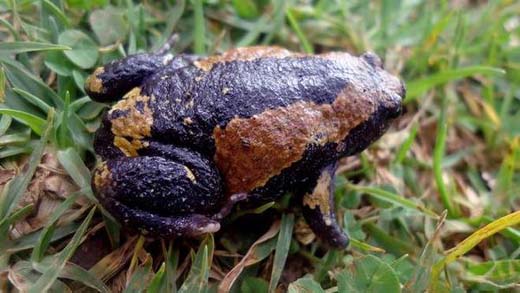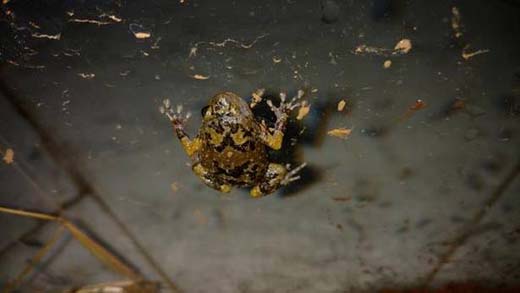Frogs with missing eyes, extra limbs alarm scientists
Mangalore Today News Network
Chennai, Nov 13, 2017 : The Western Ghats have been witnessing an unusual number of frogs with deformities. Scientists and public health experts are alarmed by the phenomenon, which they suspect to be symptomatic of underlying toxicity in the environment and the food chain.

“Missing eyes, deformed hind legs, missing limbs, extra limbs, partial limbs, limbs that are bent or bony, and abnormally thin or weak limbs are some of the reported frog abnormalities in the Western ghats,” said Dr. S. Muralidharan from the Division of Ecotoxicology at Salim Ali Centre for Ornithology & Natural History.
Since frogs are very sensitive to changes in their habitats, studying them would yield clues to the state of the environment, says Dr. Karthikeyan Vasudevan of the Centre for Cellular and Molecular Biology (CCMB), Hyderabad. “A few decades ago, the population of the bald eagle came down in the United States due to use of the DDT pesticide. We cannot commit a similar mistake. More studies are needed to fully understand the issue,” he said.
Independent studies on the excessive use of pesticides and on the impact of pesticides on amphibians in laboratory conditions suggest a strong link between pesticide use and frog deformities.
Dr. H.P. Gurushankara from the Central University of Kerala and Dr. S.V. Krishnamurthy from Kuvempu University, Karnataka, conducted a survey in the early 2000s and found an increased number of deformities in the frogs inhabiting paddy fields. Not only do many amphibians breed in the shallow waters of paddy fields, pesticide applications also coincide with the breeding periods of frogs.

“Considering the scenario of global amphibian population decline, we analysed the impact of pesticides on the amphibians in laboratory conditions and concluded that pesticides could act as a major factor behind the depletion of larval and adult population,” Dr. Gurushankara said.
The cardamom plantations of Kattapana, which reportedly use a large number of illegal pesticides, are also suspect. “These pesticides are banned in Kerala. But they are illegally brought in from Tamil Nadu,” said Dr. Muthuswamy Murugan from Kerala Agricultural University.
“Pesticides mainly affect the reproductive health of frogs. But the deformities are only 10% of the actual problem. These chemicals ultimately reach the soil and move into the water system where the larval stage (tadpoles) of the frog develops. We are studying the causes of these deformities though ‘in vitro’ conditions, and trying to assess the environmental health of the region,” said Dr. S.D. Biju from Delhi University.
courtesy:The Hindu
- Kasaragod: Missing Schoolgirl and Driver Found Dead in Merkala Forest After 26 Days
- The Intriguing Story Behind Diganth’s Mysterious Disappearance!
- Tamil Nadu CM M.K. Stalin’s Wife Visits Kollur Mookambika Temple
- Mangaluru Couple Completes Mumbai-to-Mangaluru Marathon, Eyes Guinness Record
- Eminent Aloysian Alumni Award 2025 Honors Five Achievers
- Udupi: Women Have Proved Their Strength in Every Field, Says Sri Sugunendra Thirtha Swami
- Missing II PUC Student Diganth found in Udupi after 10-day search
- Daylight burglary: Gold ornaments stolen from house in Vittal
- Illegal cattle transport: Three arrested after car crash near Gangolli
- District BJP stages protest; alleges injustice to DK in state budget
- Deputy Lokayukta inspects Varamballi waste unit, Kaup dumping yard
- Attempt to deactivate mobile jammers: Case filed against 9 prisoners
- Moobidri: Teacher dies in scooter-car collision
- Devotees Flock to Prayagraj’s Sangam Even After Maha Kumbh Ends
- India Condemns Vandalism at Hindu Temple in California, Calls for Strict Action
- Delhi CM Rekha Gupta-led cabinet approves ₹2,500 monthly aid for women
- After Ranya Rao’s arrest, CBI to probe international gold smuggling ring
- In a first, all-women crew runs Vande Bharat on International Women’s Day
- Elderly woman falls after wheelchair delay, Air India flags late arrival
- Jinnah must be happy with Siddaramaiah’s budget, says CT Ravi
- Chess star to Space scientist: Women achievers take over PM Modi’s X handle
- Two women, including Israeli tourist, raped near Hampi
- Over 140 killed in clashes between Syrian forces and Assad loyalists
- Actor Ranya Rao admits to role in gold smuggling; DRI gets 3-day custody
- Relief for Siddaramaiah’s wife in MUDA case, probe agency summons cancelled
- Court remands Maoist Lakshmi to six-day police custody
- Sandhya Shenoy honored with Society for Materials Chemistry Medal-2024
- White Cornus Apartment in Mangaluru
- City girl wins first place in state-level spell bee competition
- Alleged ‘Love Jihad’ Case in Mangaluru: Woman left home voluntarily, says police
- Girl fatally struck by reckless two-wheeler near Belman
- New residential complex for the judges inaugurated in Mangaluru
- Absconding accused nabbed after 8 years
- Truck with cylinders turns turtle in Beltangady
- Bhoota Kola artist dies of cardiac arrest
- Development of the country should be our goal: Ganesh Karnik
- Container truck gets stuck under Modankap railway bridge
- Truck crushes bike’s pillion rider near BC Road
- Head constable dies of heart attack
- Udupi: PDO dismissed over financial irregularities
- CITY INFORMATION
- TRAVEL
- TOURIST INFORMATION
- HEALTH CARE
- MISCELLANEOUS




 Write Comment
Write Comment E-Mail To a Friend
E-Mail To a Friend Facebook
Facebook Twitter
Twitter  Print
Print 




